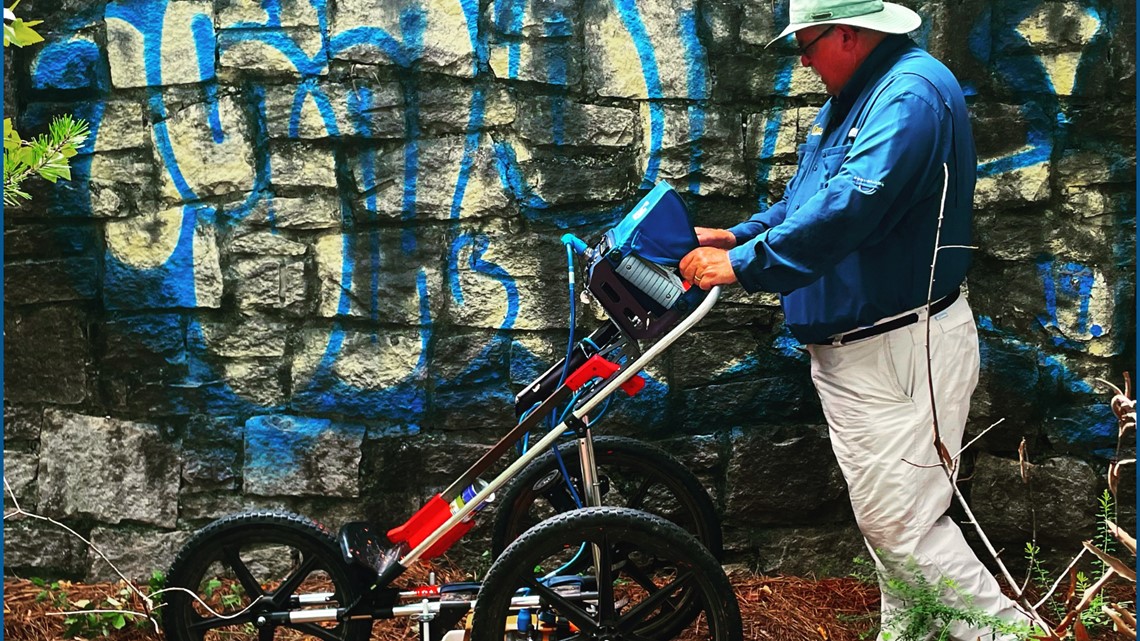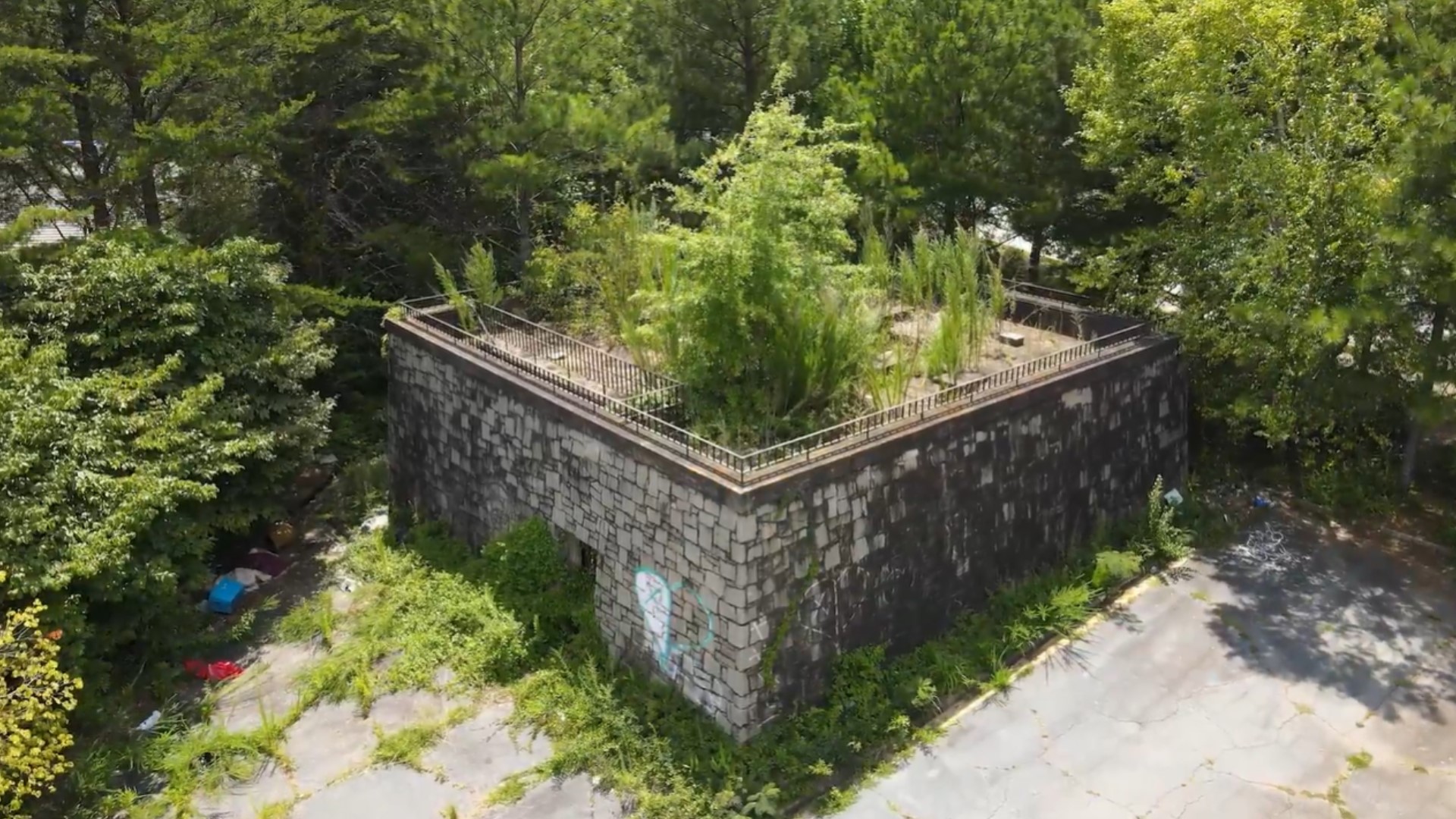DECATUR, Ga. — Every day thousands of cars drive by what looks like an ordinary parking lot in Decatur, Georgia. But there is nothing ordinary about it.
A memorial, many don’t even know exists, sits roughly 300 feet from Memorial Drive. The mausoleum, a Civil War-era burial site, is enclosed by 15-feet tall granite walls. It’s seen better days. Graffiti stains the outside of the shrine while inside overgrown trees and grass cover the tombs. But Jessica Derise was drawn to it.
“I’m a big fan of the website Atlas Obscura,” Derise said. “It lists all the curious attractions in the area so to speak, so I found it on there and I thought, ‘that’s at my local Walmart.’”
Yes, the more than 100-year-old final resting place lies near a Walmart parking lot as well as a Napa Auto Parts. But that’s not what captivated Derise. It was the name of the mausoleum that caught her attention: The Crowley Mausoleum.
“I remembered in the back of my head I had a Crowley far, far back in my line. Seven, eight generations back,” she said. “And I realized, oh my gosh, my ancestors are buried there."
That could be a story alone. A Decatur woman just happening upon a forgotten cemetery and finding out she’s related to the people buried within its walls. But it turns out there may be more to the story -- outside the mausoleum and underneath an area near a Walmart parking lot, there are reportedly unmarked graves with slaves possibly buried inside.
“It was told again and again online that there are 40 to 50 slaves buried underneath here,” Derise said.
She reached out to 11Alive’s Reveal Investigators to see if that was fact or fiction, and we brought in an expert on the matter, Len Strozier.
Strozier said he’s been mapping cemeteries for more than 14 years, using Ground Penetrating Radar or GPR. He owns his own company, Omega Mapping Services, and travels the country with his technology that can uncover burials no one knew existed.
“The largest one I did was an 86-acre cemetery in Brunswick, Georgia where we found 3,700 unmarked burials,” Strozier said.


Strozier said he's seen a lot in his career, but he’s never seen anything like the Crowley Mausoleum.
“I’d always heard about this one, but I never made the trek over here to look at it,” he said.
At first glance, Strozier said he’d be surprised to find any unmarked graves near the mausoleum. He wasn’t the only skeptic.
“This original property had hundreds of acres and when you get to oral histories that were written down 150 years later, you’re using family lore that has come down,” said Melissa Forgey, Executive Director of the DeKalb History Center Museum.
Forgey said a mall was built in the area before the Walmart arrived. Construction started in the 1960s, around the time the mausoleum was built. The mausoleum was meant to protect the Crowley family plot, which sat on a hill in the 1800s. That’s why the graves can be seen from the top of the mausoleum.
“For this mausoleum to be created to save this one in the place that it was established is actually pretty interesting,” said Forgey.
But the land around the mausoleum was not saved. Over the years, as developers moved into the area, the land was graded to make way for buildings and parking lots.
“When they graded, they may have unwittingly known that they were taking burials with them whenever they would take dirt,” said Strozier.
Strozier believed if anyone was buried outside of the mausoleum, their remains and any sign of a burial were long gone.
Still, armed with the technology that could provide those answers, he began to scan the parking lot. The ground-penetrating radar system looks for air pockets, which are the biggest indicators of a grave.
“When a body decomposes, all it does is leave an air pocket,” said Strozier.
After roughly an hour, Strozier’s scans revealed nothing more than what you’d expect to find under a parking lot like tree roots and pipes. But just when he thought his initial suspicions were correct, he found an air pocket.
“It looks like it’s a wooden casket and it looks like the wooden casket is intact,” said Strozier.
The cemetery scan expert continued scrutinizing the parking lot. He found more air pockets.
RELATED: Critics claim skate park may have been built on graves at 19th century African American cemetery
Strozier uncovered a total of 10 air pockets west of the mausoleum, but he was unable to scan the entire lot. A temporary COVID-19 testing site is using the parking lot, and on this particular day, it was packed with cars.
Still, the evidence he did find seems to point to Derise’s suspicions that this parking lot covers a century-old cemetery. What it doesn’t prove is whether any of the potential unmarked graves belonged to slaves.
“That would be nothing but assumption. I can show you what and where, but I cannot tell you who,” Strozier said.
Exhuming any potential bodies would also likely be impossible.
“If you dig a burial that’s been there over 100 years, everything’s gone. Everything decomposes,” Strozier said.
But Derise is hopeful that if those air pockets are in fact graves, something is done to honor the dead.
“Some sort of ceremony, some sort of prayer, some sort of ritual that will do its peace in righting this injustice,” she said.
That way, when the thousands of cars come down Memorial Drive, they see more than an ordinary parking lot. They see a proper memorial.
The owners of the property provided 11Alive with this statement about our find:
"We are sympathetic to this issue and will look and see what can be done so this area is treated with respect. We are trying to figure out exactly what's there and what our options are moving forward."

